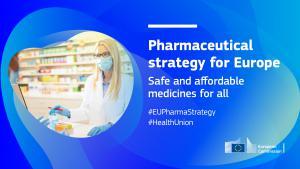
On 25 November, the Commission adopted a Pharmaceutical Strategy for Europe to ensure patients have access to innovative and affordable medicines and to support the competitiveness, innovative capacity and sustainability of the EU's pharmaceutical industry.
The Strategy will allow Europe to cover its pharmaceutical needs, including in times of crisis, through robust supply chains. A key component of building a stronger European Health Union, as called for by President von der Leyen in her State of the Union Speech, the Strategy will help to establish a future-proof and crisis-resilient EU pharmaceutical system.
Europe's Pharmaceutical Strategy has four main objectives:
- Ensuring access to affordable medicines for patients, and addressing unmet medical needs (e.g. in the areas of antimicrobial resistance, cancer, rare diseases);
- Supporting competitiveness, innovation and sustainability of the EU's pharmaceutical industry and the development of high quality, safe, effective and greener medicines
- Enhancing crisis preparedness and response mechanisms, and addressing security of supply;
- Ensuring a strong EU voice in the world, by promoting a high level of quality, efficacy and safety standards.
Although the Strategy is much more than a crisis-response instrument, it draws lessons from the initial response to the COVID-19 pandemic, and makes Europe's pharmaceutical sector better prepared and more resilient.
The Strategy presents concrete actions to ensure accessibility, availability and affordability of medicines. It supports diversified and secure supply chains, ensuring the EU's open strategic autonomy in the world, and it promotes environmentally sustainable pharmaceuticals.
The Strategy will also ensure that the EU's pharmaceutical policy continues to serve public health in an ever-changing environment of scientific and commercial transformations. It will support patient centred innovations and accommodate digital and technological change.
Members of the College said
President of the European Commission, Ursula von der Leyen, stated: “The coronavirus pandemic has highlighted the vital need to strengthen our health systems. This includes access to safe, effective and high-quality medicines at an affordable price. In the challenging economic and social times the EU is currently facing, the strategy adopted today will ensure that Europe and Europeans will continue to benefit from such medicines. I call on Member States and the Parliament to endorse this approach which will be rolled out in the next three years, and beyond.”
Vice-President for Promoting the European Way of Life, Margaritis Schinas, said: “Effective and safe medicines, vaccines and treatments have helped to tackle some of the leading causes of disease and life-threatening illnesses in the past. These products will be crucial to uphold the health and well-being of the European citizens in these challenging times. Today's strategy supports the EU's pharmaceutical industry to remain competitive and innovative, whilst addressing the needs of the patients and those of our health systems.”
Stella Kyriakides, Commissioner for Health and Food Safety, stressed: “Today we launch the work to ensure that safe and effective medicines are accessible and affordable at all times and to all patients across the EU. With our Pharmaceutical Strategy for Europe, we are delivering on our commitment to create a future-proof and patient-centred pharmaceutical environment in which the EU industry can innovate, flourish and continue to be a global leader. It is our long-term vision for open strategic autonomy, and our response to the challenges of today and the vulnerabilities exposed by COVID-19. Today we put in place another pillar of the European Health Union.”
Background
The Pharmaceutical Strategy for Europe marks the beginning of a process: its implementation includes an ambitious agenda of legislative and non-legislative actions which will be launched over the coming years.
Actions will cover the whole ecosystem of pharmaceuticals, but also some aspects of medical devices. It creates synergies with the Green Deal and our actions under the EU Strategic approach of pharmaceuticals in the environment to reduce their environmental risk, address pollution from pharmaceutical residues and promote greener manufacturing, use and disposal (a progress report is published today; LINK). It is also linked to the action plan on Intellectual Property presented today (hyperlink to be inserted by SPP).
The flagship actions of the Strategy include:
- A revision of the basic pharmaceutical legislation* (target date for a proposal: 2022) with a view to making this framework future-proof and innovation friendly;
- A proposal for a EU Health Emergency Response Authority (proposal: 2nd semester 2021);
- A revision of the regulations on medicines for children and rare diseases
- Initiating a structured dialogue with and between all actors in the pharmaceutical manufacturing and public authorities to identify vulnerabilities in the global supply chain of critical medicines and shape policy options to strengthen the continuity and security of supply in the EU;
- Cooperation between national authorities on pricing, payment and procurement policies, to improve the affordability, cost-effectiveness of medicines and health system's sustainability;
- The creation of a robust digital infrastructure, including a proposal for a European Health Data Space (target date for a proposal: 2021);
- Support to research and innovation, notably via Horizon 2020 and EU4Health;
- Actions to promote innovative approaches to EU R&D and public procurement for antimicrobials and their alternatives and measures to restrict and optimise their use.
Next Steps
The Strategy will be discussed at political level at the EPSCO Council Meeting on 2 December 2020.
For More Information
Details
- Publication date
- 25 November 2020
